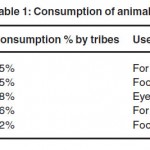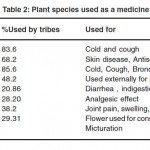Impact of Biodiversity in Tribal life of Tripura
Biplab De1 and Trijash Debbarma2
1
Regional Institute of Pharmaceutical Science and Technology,
Abhoynagar,
Agartala,
Tripura,
799005
India
2
Singhania University,
Pacheri Bari,
Rajasthan,
India
DOI: http://dx.doi.org/10.12944/CWE.6.2.18
Tribal people of Tripura is fully utilizing the biodiversity as to consume, to build house, crafts, to manufacture tools, instruments and medicinal purposes etc., but equally not conserved.
Copy the following to cite this article:
De B, Debbarma T. Impact of Biodiversity in Tribal life of Tripura. Curr World Environ 2011:6;301-302 DOI:http://dx.doi.org/10.12944/CWE.6.2.18
Copy the following to cite this URL:
De B, Debbarma T. Impact of Biodiversity in Tribal life of Tripura. Curr World Environ [serial online] 2011;6:301-302. Available from: http://www.cwejournal.org/?p=1453
Download article (pdf)
Citation Manager
Publish History
Select type of program for download
| Endnote EndNote format (Mac & Win) | |
| Reference Manager Ris format (Win only) | |
| Procite Ris format (Win only) | |
| Medlars Format | |
| RefWorks Format RefWorks format (Mac & Win) | |
| BibTex Format BibTex format (Mac & Win) |
Article Publishing History
| Received: | 2011-09-02 |
|---|---|
| Accepted: | 2011-10-17 |
Introduction
Tripura is a small state located in the north-eastern part of India. It has a international border with Bangladesh for about 839 kms, towards West, South and North. It also shares boundary with Assam and Mizoram in the east. The geographical continuity with the Indian main land is maintained only in the north east with Karimganj sub-division in Cachar district of Assam. The small geographical area however does not deprive Tripura in being one of the richest areas with regards to the biodiversity and biological Resources. Agartala which is the capital city of the state of Tripura has a forest cover of 214.582 kms. At Agartala there is 15,616 Tribal population in which 7,686 are males and 7,930 are according to 2001 census. In recent years there are various studies noted on the biodiversities. Biodiversity have great impact in the socioeconomic and cultural aspect in the tribal life at Agartala, Tripura. It is estimated that about 86% of species occurring in Tripura are widely distributed in India and adjoining countries and 14% of the species are comparatively restricted in distribution. Certain parameters of environment and biodiversity were reported in regard to the tribal people of Tripura.1
The present study is done to investigate the impact of biodiversity on the tribal life and the study was carried out in the capital of Tripura, India, - Agartala.
Materials and Method
Studies were carried out basically on fire wood consumption, food consumption, timber usage, usage of bamboo, bamboo shoot consumption, wild potato tuber consumption, medicinal plant usage, consumption of animal flesh like pig etc., by the tribal people of Tripura. Studies were carried out in the Agartala, the capital of Tripura, India. Extensive survey was done through out Agartala subdivision among the tribal people based on the prefixed parameters through an eventually prepared format. Interview was conducted among the tribal people and information from the governmental organization was also collected. Collected data was tabulated and presented accordingly.
Results and Discussion
In Agartala, data collected from more than 60% (60.83%) tribal people were dwelling in urban sector and 39.2% dwelling in rural area. Among the respondents, maximum were students (36.67%), farmer(25%) and employees(24.17%), apart from these data also were collected from businessmen (1.66%), labour class (6.7%), house wives (5.83%). Among them, 14.17% reported their monthly income more than Rs. 10,000/-, 44.17% reported more than Rs. 5000/- and 41.67% less than Rs. 5000/-. 75% Tribal people reported that they used to eat tubers of Dioscorea sp. after cooking and 25% generally consume as raw. Bamboo shoots are very favourble to them and they used to consume after cooking only. They mostly favours the shoot of Melacana baccifera (89.16%) and others are Bambusa balcooa (52.5%) and Bambusa tulda (49.16%). Tribal people also consume animal flesh as depicted in Table 1. They too believe that these are having certain medicinal value, such as Monoptera kuchia favoured by 75% respondents and they believed that it increases blood quantity in body. They also favour Sus scrofa, Pila sp., Pitta brachyuran, Columba livia etc. Tribal people utilizes bamboo of different sp. for building house (94.16%), fencing purpose (94.16%), in crafts (85%), to manufacture instruments (75.83%), different tools (50%) etc. Plants are also used as fire wood and 43% reported that they are utilizing plants as fire wood and 53% are not utilising. Probable plants are Cassia fistula, Azadiracta indica, Artocarpush eterophilus, Embilica officinalis. Tribal people are also using certain plants for medicine purpose as mentioned in Table 2, such as 83.6% using Adhatoda vasica in cough and cold; Ocimum sanctum used by 85.6% for cold, cough and bronchitis; 68.2% using Azadirachta indica in skin disease and as antiseptic; etc. Ultimately, it has been that tribal people are utilizing the biodiversity to fulfill their needs and daily livelihood, but equally the conservation was not recorded or found.
 |
Table 1: Consumption of animals Click here to View table |
 |
Table 2: Plant species used as a medicine Click here to View table |
References
1. De B., Debbarma T., Sen S. and Chakraborty R. Current World Environment, 2010; 5(1): 59.






